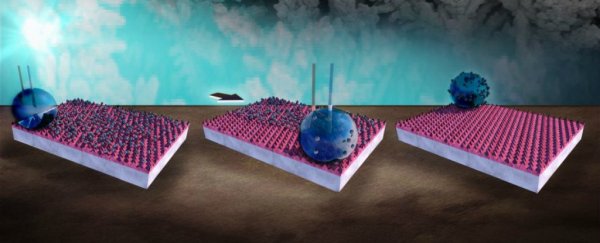Scientists have created a material that can switch between repelling and absorbing water droplets at the flick of a switch.
The copper based material can go from super hydrophobic (water hating) to super hydrophilic (water loving) in a matter of seconds and could be used for water filtration, biomedical devices, liquid lenses and smart self-cleaning surfaces.
Super hydrophobicity is something that's incredibly satisfying to watch. We've seen hydrophobic knives slice through water with ease, cause water to bounce off surfaces like tennis balls and you'd be lying if you said that watching super hydrophobic materials on YouTube didn't fill a hole in your life you didn't know existed.
And on the other side of the coin, super hydrophilicity is used to pull drinking water straight from the air and used to create self-cleaning glass.
But what about a material that can switch between both of these properties?
In the past, scientist have attempted to make these type of materials with heat treatment or bombarding the copper with UV and X-rays but the treatment takes hours or days and severely limits the applications.
This new study creates a material that can switch properties in seconds – instead of hours – and it'll surprise you with how simple it turned out to be.
The scientists used a copper based surface which changes from water loving to water hating by simply changing the voltage applied across the surface. The voltage required to change the properties of the surface is as low as 1.5 volts – lower than that found in a normal household battery.
"When tiny voltages are applied to the surface, water droplets that initially roll off stick to it more and more tightly," says Ben Zahiri, one of the researchers, from the University of British Columbia (UBC).
"By changing the magnitude of the voltage and how long it is applied, we can easily control the angle that each droplet forms with the surface and how quickly this happens."
The copper is deposited on a surface by a process called electrodeposition, which causes the copper to grow like an array of Christmas trees
This this what the surface looks like:
 UBC
UBC
The material works by changing the oxidation state of the copper surface; as copper loses electrons, it becomes less attracted to water.
At zero volts, the water sits on top of the Christmas trees and as soon as the voltage is applied the water seeps into the Christmas tree surface.
Things got stranger when they changed the voltage while the droplet remained on the surface.
When the scientists switched the material from super hydrophobic to super hydrophilic it acted as an electric sponge that held onto and released liquids at the press of a button – something really useful for dealing with hazardous material spills.
The team from chose copper because it is cheap and abundant and is one of the most commonly used metals in the world.
Zahiri believes that the electrochemical manipulation of other metals, metal oxides, and mixed oxides may yield similarly promising results.
Although they didn't test it directly, the scientists say the material could be used to manipulate any conducting liquid, which includes blood.
"These findings could open up a new area of exploration for smart surfaces," says lead researcher Walter Mérida.
We can't wait to waste hours watching these new materials on YouTube.
This study was published in Advanced Materials Interfaces.
